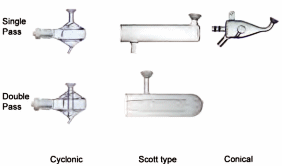
The spray chamber is part of the sample introduction system for liquid samples of a spectroscopic source such as a flame or plasma. The function of the spray chamber is to filter the aerosol produced by the nebulizer (primary/secondary aerosol) so that only the smallest reach the source (tertiary aerosol). The most commonly used spray chambers in plasma spectrochemistry are the cyclonic, barrel (or Scott-type), and conical (see figure).
The cyclonic and Scott-type spray chambers are available as both single and double pass (or baffled) versions. The double-pass mode acts as a secondary filter to further reduce the mean droplet site distribution (reducing the aerosol transport efficiency and reducing the noise level). The conical spray chamber uses an impact bead to break-up larger droplets. In all three designs gravity is used to remove the larger drops from the transport gas stream and divert them to the drain. Total transport efficiency is typically below 5 %. In the cyclonic spray chamber this action is assisted by centrifugal forces.